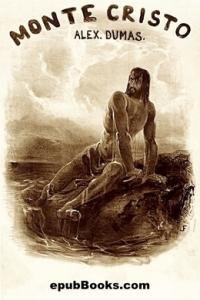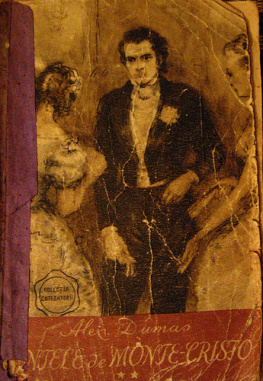Alexandre Dumas pere - The Count of Monte Cristo (Penguin Classics)
Here you can read online Alexandre Dumas pere - The Count of Monte Cristo (Penguin Classics) full text of the book (entire story) in english for free. Download pdf and epub, get meaning, cover and reviews about this ebook. year: 2003, publisher: Penguin Classics, genre: Art. Description of the work, (preface) as well as reviews are available. Best literature library LitArk.com created for fans of good reading and offers a wide selection of genres:
Romance novel
Science fiction
Adventure
Detective
Science
History
Home and family
Prose
Art
Politics
Computer
Non-fiction
Religion
Business
Children
Humor
Choose a favorite category and find really read worthwhile books. Enjoy immersion in the world of imagination, feel the emotions of the characters or learn something new for yourself, make an fascinating discovery.
- Book:The Count of Monte Cristo (Penguin Classics)
- Author:
- Publisher:Penguin Classics
- Genre:
- Year:2003
- Rating:4 / 5
- Favourites:Add to favourites
- Your mark:
- 80
- 1
- 2
- 3
- 4
- 5
The Count of Monte Cristo (Penguin Classics): summary, description and annotation
We offer to read an annotation, description, summary or preface (depends on what the author of the book "The Count of Monte Cristo (Penguin Classics)" wrote himself). If you haven't found the necessary information about the book — write in the comments, we will try to find it.
The Count of Monte Cristo (Penguin Classics) — read online for free the complete book (whole text) full work
Below is the text of the book, divided by pages. System saving the place of the last page read, allows you to conveniently read the book "The Count of Monte Cristo (Penguin Classics)" online for free, without having to search again every time where you left off. Put a bookmark, and you can go to the page where you finished reading at any time.
Font size:
Interval:
Bookmark:

THE COUNT OF MONTE CRISTO
ALEXANDRE DUMAS was born in 1802 at Villers-Cotterts. His father, the illegitimate son of a marquis, was a general in the Revolutionary armies, but died when Dumas was only four. He was brought up in straitened circumstances and received very little education. He joined the household of the future king, Louis-Philippe, and began reading voraciously. Later he entered the cnacle of Charles Nodier and started writing. In 1829 the production of his play, Henri III et sa cour, heralded twenty years of successful playwriting. In 1839 he turned his attention to writing historical novels, often using collaborators such as Auguste Maquet to suggest plots or historical background. His most successful novels are The Count of Monte Cristo, which appeared during 18445, and The Three Musketeers, published in 1844. Other novels deal with the wars of religion and the Revolution. Dumas wrote many of these for the newspapers, often in daily instalments, marshalling his formidable energies to produce ever more in order to pay off his debts. In addition, he wrote travel books, childrens stories and his Mmoires which describe most amusingly his early life, his entry into Parisian literary circles and the 1830 Revolution. He died in 1870.
ROBIN BUSS is a writer and translator who contributes regularly to The Times Educational Supplement, The Times Literary Supplement and other papers. He studied at the University of Paris, where he took a degree and a doctorate in French literature. He is part-author of the article French Literature in Encyclopaedia Britannica and has published critical studies of works by Vigny and Cocteau, and three books on European cinema, The French through Their Films (1988), Italian Films (1989) and French Film Noir (1994). He is also part-author of a biography, in French, of King Edward VII (with Jean-Pierre Navailles, published by Payot, Paris, 1999). He has translated a number of other volumes for Penguin, including Jean Paul Sartres Modern Times, Zolas LAssommoir and Au Bonheur des Dames, and Albert Camuss The Plague.
ALEXANDRE DUMAS (PRE)
Translated and with an Introduction and Notes by
ROBIN BUSS
PENGUIN BOOKS
PENGUIN BOOKS
Published by the Penguin Group
Penguin Books Ltd, 80 Strand, London WC2R 0RL, England
Penguin Putnam Inc., 375 Hudson Street, New York, New York 10014, USA
Penguin Books Australia Ltd, 250 Camberwell Road, Camberwell, Victoria 3124, Australia
Penguin Books Canada Ltd, 10 Alcorn Avenue, Toronto, Ontario, Canada M4V 3B2
Penguin Books India (P) Ltd, 11 Community Centre, Panchsheel Park, New Delhi 110 017, India
Penguin Books (NZ) Ltd, Cnr Rosedale and Airborne Roads, Albany, Auckland, New Zealand
Penguin Books (South Africa) (Pty) Ltd, 24 Sturdee Avenue, Rosebank 2196, South Africa
Penguin Books Ltd, Registered Offices: 80 Strand, London WC2R 0RL, England
www.penguin.com
First published 18445
This translation first published 1996
Reissued with new Chronology and Further Reading 2003
1
Copyright Robin Buss, 1996, 2003
All rights reserved
The moral right of the translator has been asserted
Except in the United States of America, this book is sold subject
to the condition that it shall not, by way of trade or otherwise, be lent,
re-sold, hired out, or otherwise circulated without the publishers
prior consent in any form of binding or cover other than that in
which it is published and without a similar condition including this
condition being imposed on the subsequent purchaser
EISBN: 9780141901251
1802 Alexandre Dumas is born at Villers-Cotterts, the third child of Thomas-Alexandre Dumas. His father, himself the illegitimate son of a marquis and a slave girl of San Domingo, Marie-Cessette Dumas, had had a remarkable career as a general in the Republican, then in the Napoleonic Army.
1806 General Dumas dies. Alexandre and his mother, Elisabeth Labouret, are left virtually penniless.
1822 Dumas takes a post as a clerk, then in 1823 is granted a sinecure on the staff of the Duke of Orlans. He meets the actor Talma and starts to mix in artistic and literary circles, writing sketches for the popular theatre.
1824 Dumas son, Alexandre, future author of La Dame aux camlias, is born as the result of an affair with a seamstress, Catherine Lebay.
1829 Dumas historical drama, Henri III et sa cour, is produced at the Comdie-Franaise. It is an immediate success, marking Dumas out as a leading figure in the Romantic movement.
1830 Victor Hugos drama Hernani becomes the focus of the struggle between the Romantics and the traditionalists in literature. In July, the Bourbon monarchy is overthrown and replaced by a new regime under the Orlanist King Louis-Philippe. Dumas actively supports the insurrection.
1831 Dumas melodrama Antony, with its archetypal Romantic hero, triumphs at the Thtre de la Porte Saint-Martin.
1832 Dumas makes a journey to Switzerland which will form the basis of his first travel book, published the following year.
1835 Dumas travels to Naples with Ida Ferrier (whom he will later marry), has a passionate affair in Naples with Caroline Ungher and falls in love with Italy and the Mediterranean.
1836 Triumph of Dumas play Kean, based on the personality of the English actor whom Dumas had seen performing in Shakespeare in 1828.
1839 Mademoiselle de Belle-Isle. Dumas greatest success in the theatre.
1840 Dumas marries Ida Ferrier. He travels down the Rhine with Grard de Nerval and they collaborate on the drama Lo Burckart. Nerval introduces Dumas to Auguste Maquet who will become his collaborator on many of his subsequent works.
1841 Spends a year in Florence.
1844 The year of Dumas two greatest novels: The Three Musketeers starts to appear in serial form in March and the first episodes of The Count of Monte Cristo follow in August. Dumas starts to build his Chteau de Monte-Cristo at St-Germain-en-Laye. He separates from Ida Ferrier.
1845 Twenty Years After, the first sequel to The Three Musketeers, appears at the beginning of the year. In February, Dumas wins a libel action against the author of a book accusing him of plagiarism. Publishes La Reine Margot.
1846 Dumas travels in Spain and North Africa. Publishes La Dame de Monsoreau, Les Deux Diane and Joseph Balsamo.
1847 Dumas theatre, the Thtre Historique, opens. It will show several adaptations of his novels, including The Three Musketeers and La Reine Margot. Serialization of The Vicomte de Bragelonne, the final episode of the The Three Musketeers.
1848 A revolution in February deposes Louis-Philippe and brings in the Second Republic. Dumas stands unsuccessfully for Parliament and supports Louis-Napolon, nephew of Napoleon I, who becomes President of the Republic.
1849 Dumas publishes The Queens Necklace.
1850 Dumas is declared bankrupt and has to sell the Chteau de Monte-Cristo and the Thtre Historique. Publishes The Black Tulip.
1851 In December, Louis-Napolon seizes power in a coup dtat, effectively abolishing the Republic. A year later, the Second Empire will be proclaimed. Victor Hugo goes into exile in Belgium where Dumas, partly to escape his creditors, joins him.
1852 Publishes his memoirs.
1853 In November, returns to Paris and founds a newspaper,
Next pageFont size:
Interval:
Bookmark:
Similar books «The Count of Monte Cristo (Penguin Classics)»
Look at similar books to The Count of Monte Cristo (Penguin Classics). We have selected literature similar in name and meaning in the hope of providing readers with more options to find new, interesting, not yet read works.
Discussion, reviews of the book The Count of Monte Cristo (Penguin Classics) and just readers' own opinions. Leave your comments, write what you think about the work, its meaning or the main characters. Specify what exactly you liked and what you didn't like, and why you think so.





